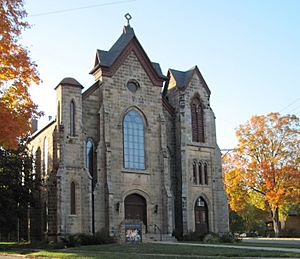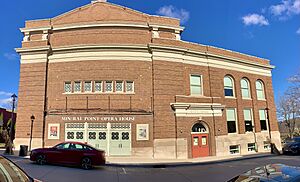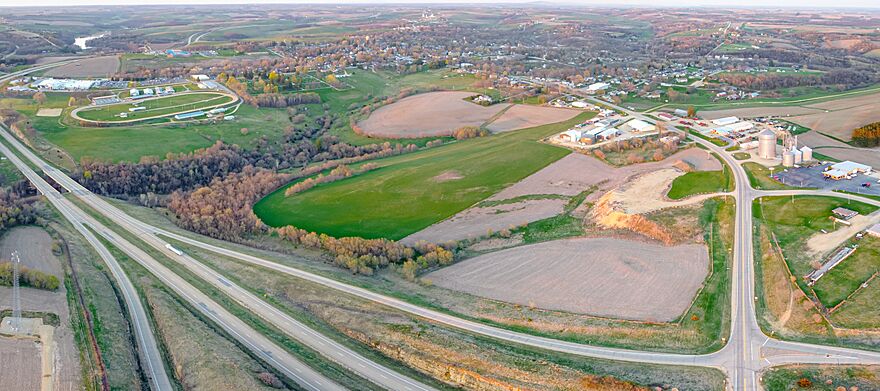Mineral Point, Wisconsin facts for kids
Quick facts for kids
Mineral Point, Wisconsin
|
|
|---|---|

High Street, Mineral Point
|
|

Location of Mineral Point in Iowa County, Wisconsin.
|
|
| Country | |
| State | |
| County | Iowa |
| Settled | 1827 |
| Area | |
| • Total | 3.08 sq mi (7.97 km2) |
| • Land | 3.08 sq mi (7.97 km2) |
| • Water | 0.00 sq mi (0.00 km2) |
| Population
(2020)
|
|
| • Total | 2,581 |
| Time zone | UTC-6 (Central (CST)) |
| • Summer (DST) | UTC-5 (CDT) |
| Area code(s) | 608 |
| FIPS code | 55-53100 |
Mineral Point is a city in Iowa County, Wisconsin, United States. In 2020, about 2,581 people lived there. The city is known for its rich history, especially its past as a mining town.
Mineral Point was founded in 1827. It quickly became a busy center for mining lead and zinc. Many Cornish immigrants, who were skilled miners, moved here with their families. Later, in the mid-1900s, artists discovered the city. They created an artist's colony, and tourism began to grow. Today, Mineral Point is a popular place to visit because of its well-preserved historic buildings and beautiful natural setting.
Contents
Discovering Mineral Point's Past
The first European settlers arrived in Mineral Point in 1827. One of the first was Henry Dodge and his family. Soon after, large amounts of galena, which is lead ore, were found close to the surface. Lead was very useful back then, so many people came hoping to find it easily.
Mineral Point became the main center for lead mining in what is now Wisconsin. By 1829, so many people lived here that Iowa County was created. Mineral Point was chosen as the county's main town. During the Black Hawk War in 1832, people in Mineral Point built Fort Jackson to keep the town safe.
Wisconsin Territory and Mining
In 1836, Wisconsin Territory was formed. Mineral Point was chosen for the special ceremony where the first governor, Henry Dodge, took office. The official seal for the new territory showed an arm holding a pickaxe over lead ore. This showed how important lead mining was to the area. A count of people living there showed that Iowa County was the most populated county in the territory.
Mineral Point continued to be an important lead mining town in the 1840s. Even though the easiest lead was already dug up, new immigrants arrived. They brought better ways to get the ore. Many of these new people came from Cornwall, a region in England known for mining. By 1845, about half of the town's population had Cornish family roots. You can still see some of their original homes at the Pendarvis Historic Site in Mineral Point.
Changes in Mining and County Seat
After 1848, lead mining in Mineral Point started to slow down. That year, gold was found in California. Many miners left Mineral Point to search for gold. The town lost about 700 people during this time. Even though lead mining continued into the 1860s, Mineral Point never returned to its earlier importance as a lead center.
In 1858, people in Iowa County voted to move the county seat to Dodgeville. Mineral Point disagreed and took the case to court. The Wisconsin Supreme Court first sided with Mineral Point. However, another vote was held in 1861, and the county seat officially moved to Dodgeville, where it remains today.
As lead mining decreased, zinc mining and processing became important. Zinc ore was often found deeper in the old lead mines. The Mineral Point Zinc Company started in 1882. By 1891, it had the largest zinc oxide factory in the United States. Zinc mining continued until the 1920s.
Preserving History and Art
In the 1930s, two local residents, Robert Neal and Edgar Hellum, wanted to save the old stone buildings built by the Cornish miners. They bought and restored many buildings. They even turned one into a popular Cornish restaurant. Both were artists and helped attract other artists to live in the area. These buildings are now part of the Pendarvis Historic Site.
Exploring Mineral Point's Geography
Mineral Point is located in the Driftless Area. This is a unique part of Wisconsin that was not flattened by glaciers. This means it has hills and valleys, unlike much of the surrounding land.
People of Mineral Point
The city's population has changed over the years. Here's a look at how many people have lived in Mineral Point:
| Historical population | |||
|---|---|---|---|
| Census | Pop. | %± | |
| 1860 | 2,389 | — | |
| 1870 | 3,275 | 37.1% | |
| 1880 | 2,915 | −11.0% | |
| 1890 | 2,694 | −7.6% | |
| 1900 | 2,991 | 11.0% | |
| 1910 | 2,925 | −2.2% | |
| 1920 | 2,569 | −12.2% | |
| 1930 | 2,274 | −11.5% | |
| 1940 | 2,275 | 0.0% | |
| 1950 | 2,284 | 0.4% | |
| 1960 | 2,385 | 4.4% | |
| 1970 | 2,305 | −3.4% | |
| 1980 | 2,259 | −2.0% | |
| 1990 | 2,428 | 7.5% | |
| 2000 | 2,617 | 7.8% | |
| 2010 | 2,487 | −5.0% | |
| 2020 | 2,581 | 3.8% | |
| U.S. Decennial Census | |||
Population in 2020
In 2020, there were 2,581 people living in Mineral Point. Most residents were White (95.4%). A small percentage were Asian, Black, or from other backgrounds. About 1.8% of the population identified as Hispanic or Latino.
Local Media
- The Democrat Tribune is a weekly newspaper that has been serving the community since 1849.
Getting Around Mineral Point
- The Iowa County Airport (KMRJ) helps people travel to and from the city and nearby areas.
Delicious Food in Mineral Point
Mineral Point is famous for its Cornish food. You can try traditional dishes like pasties (savory meat and vegetable pies) and figgyhobbin (a sweet, fruity bread).
Fun Things to Do
The city is home to one end of the Cheese Country Trail. This trail is popular for biking, hiking, and snowmobiling.
Sister City Connection
Mineral Point has a special connection with Redruth in Cornwall, UK. They are "sister cities," which means they share cultural ties and promote friendship.
Historic Buildings and Sites

A large part of Mineral Point is a historical district. It includes many stone cottages and businesses built by the Cornish settlers in the 1800s. The City Hall, built in 1914, also houses the library and the Opera House. The Opera House was updated in 2010.
Pendarvis is a state historical site. It shows how the original Cornish cottages looked. You can take tours there in the summer.
Shake Rag Alley has seven historic buildings. It is a community art center that offers art programs for kids and classes for adults. Down the street is Brewery Pottery, an art gallery and studio located in one of Wisconsin's oldest breweries.
Some other important historical buildings and sites include:
- Brewery Pottery, built in 1850.
- Cothern House, home of Montgomery Cothern.
- Fort Defiance, a memorial marks its location.
- Fort Jackson.
- Jerusalem Springs, where the first religious services were held.
- Walker House.
- Orchard Lawn, home of the Mineral Point Historical Society.
- Mineral Point Opera House.
- Shake Rag Alley Center for the Arts.
- Trinity Episcopal Church, built in 1845.
Famous People from Mineral Point
Many notable people have connections to Mineral Point, including:
- John Catlin, who was an acting governor of the Wisconsin Territory.
- Samuel Crawford, a Wisconsin Supreme Court judge.
- Amasa Cobb, a U.S. representative.
- Allen Ludden, a famous game show host.
- Cadwallader C. Washburn, who helped found General Mills.
See Also
 In Spanish: Mineral Point para niños
In Spanish: Mineral Point para niños




